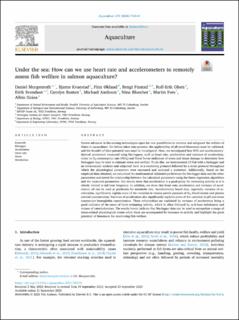Under the sea: How can we use heart rate and accelerometers to remotely assess fish welfare in salmon aquaculture?
Morgenroth, Daniel; Kvæstad, Bjarne; Økland, Finn; Finstad, Bengt; Olsen, Rolf-Erik; Svendsen, Eirik; Rosten, Carolyn; Axelsson, Michael; Bloecher, Nina; Føre, Martin; Gräns, Albin
Peer reviewed, Journal article
Published version

Åpne
Permanent lenke
https://hdl.handle.net/11250/3095431Utgivelsesdato
2023Metadata
Vis full innførselSamlinger
- Publikasjoner fra CRIStin - NINA [2364]
- Scientific publications [1392]
Originalversjon
10.1016/j.aquaculture.2023.740144Sammendrag
Recent advances in bio-sensing technologies open for new possibilities to monitor and safeguard the welfare of fishes in aquaculture. Yet before taken into practice, the applicability of all novel biosensors must be validated, and the breadth of their potential uses must be investigated. Here, we investigated how ECG and accelerometryderived parameters measured using bio-loggers, such as heart rate, acceleration and variance of acceleration, relate to O2 consumption rate (MO2) and blood borne indicators of stress and tissue damage to determine how biologgers may be used to estimate stress and welfare. To do this, we instrumented 13 fish with a biologger and an intravascular catheter and subjected them to a swimming protocol followed by a stress protocol throughout which the physiological parameters were measured and analyzed a posteriori. Additionally, based on the empirical data obtained, we calculated the mathematical relationships between the bio-logger data and the other parameters and tested the relationship between the calculated parameters using the linear regression algorithms and the measured parameters. Our results show that acceleration is a good proxy for swimming activity as it is closely related to tail beat frequency. In addition, we show that heart rate, acceleration and variance of acceleration all can be used as predictors for metabolic rate. Accelerometry based data, especially variance of acceleration, significantly explain some of the variation in venous partial pressure of O2, blood lactate and plasma cortisol concentration. Variance of acceleration also significantly explains some of the variation in pH and mean corpuscular hemoglobin concentration. These relationships are explained by variance of acceleration being a good indicator of the onset of burst-swimming activity, which is often followed by acid-base imbalances and release of catecholamines. The results herein indicate that bio-logger data can be used to extrapolate a range of stress-related physiological events when these are accompanied by increases in activity and highlight the great potential of biosensors for monitoring fish welfare. Biologger Acceleration Heart rate Stress Metabolism
